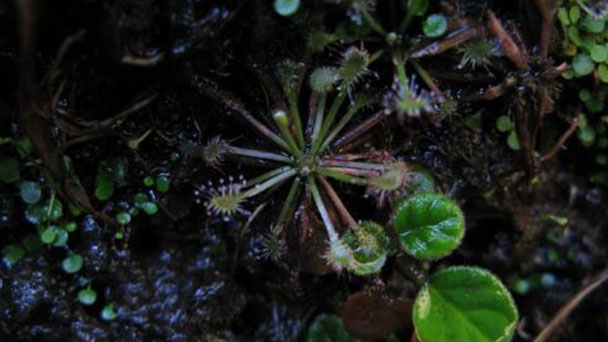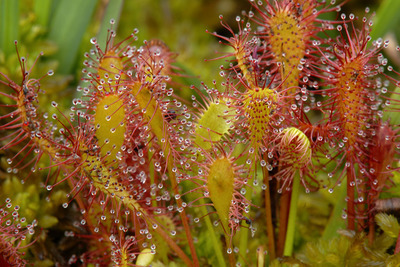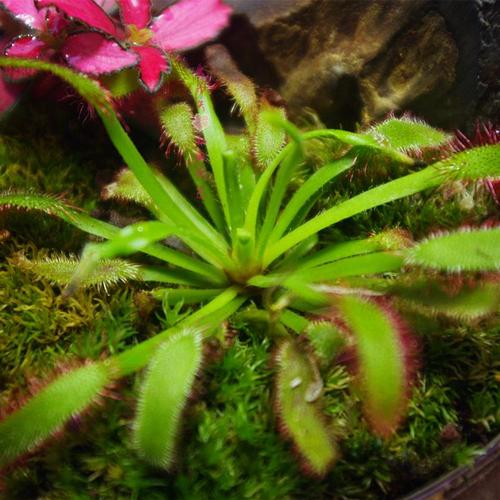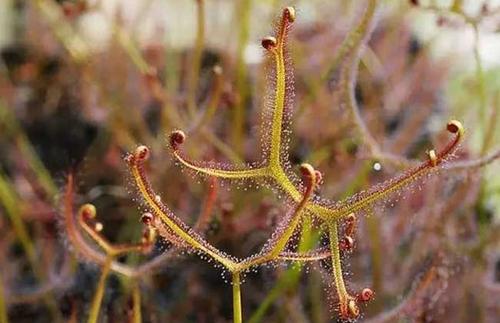Drosera peltata (shield sundew) profile
Written by Maggie
Mar 30 2021

Drosera Peltata, also called shield sundew or pale sundew, is a small perennial herb. There are globular roots under the ground. Leaves are alternate, apiculate; Leaves are slightly half - moon - shaped, the surface has many glandular hair, and can secrete mucus. Flowering in early summer; Racemes are at the apex of the branch; The flowers are small and white.
Drosera Peltata all relies on chlorophyll photosynthesis to produce nutrients for their survival. However, there are a few plants that can eat small insects to absorb nutrients. Sundew is one of these insectivorous plants.
Drosera Peltata picture

Morphological characteristics of Drosera Peltata
Drosera peltata, small delicate perennial herbs, 6 -- 25 cm tall. The root is ball. Stem is erect, slender, simple or distally branched. Root leaves are small, round, withered flowers; Cine leaves are alternate, petiolate, ca. 1 cm long; Crescent leaf, transverse diameter about 5 mm, the base was concave, the edge and leaf have most fine hairs, secreting mucus, sometimes dew-shaped, can catch insects. Inflorescence is shortly racemose, with branching tips; Flowers are small; Drosera Peltata has 5 sepals, basally conjunct, ovate, with irregular margin teeth, margin glandular hairs; 5 Petals are white, narrow and obovate, longer than sepals, with chromatic longitudinal stripes; Drosera Peltata has 5 stamens, filaments slender; Pistil is simple, ovary superior, 1 locule, style 3, digit 4 lobed. Capsule is loculicidal dehiscence. Seeds are small, elliptic, longitudinal.
Drosera Peltata is also used medicinally. Chemical composition: the whole grass contains a variety of quinones, such as isonin, moxa quinone, hydroxynaphthoquinone, hydroxynaphthoquinone and so on.The glandular hair exudates contain trypsin - like proteases. Pharmacological action: See "Bai Hua Dan" for the pharmacological action of sandisone.
The ecological habits of Drosera Peltata
Drosera Peltata is a perennial terrestrial herb. Rhizome is short. Leaves are alternate or basal, densely rosette, glandular hairy. Cymes are simple or bifurcate, terminal or axillary; Drosera Peltata distributes in the Yangtze River Basin, Pearl River Basin and southern Xizang. Drosera Peltata is also known as Shillong Sprout grass (A Study on Plant Name and Real Graph), Mountain Pepper (Classified Herbal Properties), Pepper grass (A Chronicle of Chinese Materia Medica in Sichuan), Xia Wuzao, White Flower Leaf (A Chronicle of Hunan Materia Medica), Yellow Golden Silk and Dishui Dishui (A Chronicle of Jiangsu Materia Medica).Shandi Pi (Guizhou Herbal Medicine), Cordyceps sinensis, Cordyceps sinensis, Cordyceps sinensis, Cordyceps sinensis (Fujian Chinese Herbal Medicine), Fly sinensis, Fly trap, Fly net, Pearl sinensis, Wild Sorghum (Yunnan Chinese Herbal Medicine).

Species classification of Drosera Peltata
Miniature sundew, a favorite among gamers, is also a small insect-eating plant (about the size of a coin), but it is small and delicate, and very cute!Group planting is very ornamental!In winter, a special recipe is used to propagate, and that is: long buds (called winter buds). An adult miniature sundew plant will keep growing winter buds throughout the winter, and when the winter buds mature, they will drop off or turn green. It's very small, just a millimeter, and you blow it away. Sow winter bud in water moss or peat soil above, do not cover, with watering the pot into spray shape, from the flowerpot 30CM spray water (water must be mineral less soft water) then use plastic film to cover the basin mouth, put in bright bright place, about 4~9 days as long as small mini sundew vegetables. Just out of the small, can not touch, to grow to a diameter of 0.6~1CM after the soil moved into the pot. Avoid exposure.It is an annual plant (an annual means that it will die after a year).
Cape mocha, commonly known as Cape mocha, is a carnivorous plant in South Africa.Its stem usually grows to a few centimeters high with slender leaves on it. The plant gradually sprouts many attractive flowers and sticky tentacles, waiting to catch prey.This particular plant is native to the Cape Province of South Africa.
Long Ye Mao paste food Taiwan's visible to the carnivorous plant if deduct the types of selling off the flower market, may be only a few small sundew, and of raccoon dog that chrysanthemum raccoon dog algae, sundew division long Ye Mao paste food also is one of them, and the fate of endangered species, because of its habitat only confined to the ground, and Taiwan - but the faded away after the overexploitation of man. Many plants in Taiwan, like the long-leaf sundew, are facing the fate of extinction. We can't help but ask, is there any limit to human desire? The long-leaf sundew is an annual herb of the sundew family. Its plant is quite special. The leaves are thin and long, like aliens, and the leaves are covered with a root of glandular spots, which is where it attracts insects. Because its plants are relatively large compared to small felt plants, the insects it can prey on are also quite large, and some small moths may be its prey
Roundleaf Mausoleum is a perennial herb. Leaves homebase, long stipitate; Leaf blade orbicular or fan-orbicular, 4 -- 9mm wide, base orbicular or broadly cuneate, margin densely glandular hairs; Petiole flattened, 2 -- 6cm long, pubescent. Scape 10 -- 20cm tall, slender, glabrous;Inflorescences with 3-8 flowers; Bracts small, subulate; Pedicels 1 -- 3mm long, glabrous; Calyx campanulate, ca. 4mm long, lobed to middle, glabrous, lobes narrowly ovate; Petals 5, white, spatulate, ca. 5 -- 6mm; Stamens 5; Ovary elliptic, about 3mm long, 1 locule, lateral membrane placenta 3, ovules numerous, style 3.Capsule long cylindrical.Seeds numerous, fine. Born in valleys and streams or wet meadows. It is distributed in Heilongjiang, Jilin, Guangdong, Fujian, Zhejiang, Hunan and other provinces in China. It is also found in most parts of Asia, Europe and North America.Perennial herbs of spoonleaf sundew.Stem very short.Leaves are basal, Mosaic; Leaf blade spatulate, 1 ~ 2 cm long, the upper part is round and wider, the lower part is gradually narrow, no obvious petiole, above is densely purplish red glandular hair, hair long up to 5 mm. Flower stems extracted from leaf plexus, 10 -- 15 cm tall; Flowers pale red, lateral to the top of the flower stem, arranged in a raceme; Sepals 5, persistent; Petals 5, Stamens 5; Style 3, each 2 deeply lobed.Capsule. Flowering in summer. Born in the wet slopes of mountainous areas, or near wetland ditches. Distribution in Fujian, Guangdong, Taiwan and other places.
Drosera Peltata uses
Treatment of rheumatism, rheumatoid arthritis
The Drosera Peltata whole grass is dried in the sun and ground at the end, water is mixed, mung beans or soya bean size balls apply to the affected area (pain point), plus adhesive tape is fixed, taking 24 hours. Slight burning sensation and blisters may appear after application, which is a normal reaction. Forty cases have been treated with certain effects.
Treatment of neurodermatitis
Raphani kang prevents furious empire namely (no fresh goods available with hay and white wine right amount of mash). 8 cases of neurodermatitis were treated. After 3 ~ 4 times of treatment, local itching stopped and scales fell off. The short-term effect was obtained.
Drosera Peltata is a famous insectivorous plant, and its leaves no longer contain chlorophyll, which of course does not photosynthesize to produce nutrients.Leaves small spoon shaped, covered with long glandular hair. When the insect falls into the spoon, glandular hair close insect is stuck, the insect body nutrients are decompressed and absorbed by the leaf.

Latest Updated
- Benefits of Bugleweed - 7 Science-backed Health Benefits
- Bugleweed Dangers & Side Effects - Is It Poisonous?
- How to Plant Evergreen Trees - What You Should Know
- When to Plant Evergreens - Grow Guide for Evergreen Trees
- 12 Wonderful Evergreen Shrubs for Your Garden
- 12 Popular Evergreen Plants with Pictures for Beginners
- When And How To Prune A Lilac Bush Like a Pro
- How to Grow & Care for Lilac Vine (Hardenbergia Violacea)
- Japanese Lilac Tree (Syringa Reticulata) Care & Propagation Guide
- Shumard Oak Pros and Cons - What to Know
Popular Articles
- Winter maintenance of Antirrhinum Majus
- How to Grow Terminalia Mantaly Tree
- How to Grow and Care for Crossostephium Chinense
- How to grow Antirrhinum Majus in spring
- Peristeria Elata (Dove Orchid) Profile: Info & Care Guide
- Underwatered Snake Plant (Sansevieria Trifasciata) - Signs And How To Fix
- How to Care for Brazilian Jasmine Plant (Mandevilla Sanderi)
- How to Grow & Care for Graptopetalum Purple Delight in Summer
- Rosa Chinensis (China Rose): Plant Growing & Care Tips
- How to Care for Baby Sun Rose (Aptenia Cordifolia)